Accounting - Open book exam: Case studies and ratio analysis
VerifiedAdded on 2023/06/08
|14
|2833
|500
AI Summary
This article covers case studies and ratio analysis for Accounting - Open book exam. It includes preparation of accounting equation, profit & loss account, balance sheet, computation of ratios, identification of financial strengths & weaknesses, and allocation of manufacturing overheads.
Contribute Materials
Your contribution can guide someone’s learning journey. Share your
documents today.
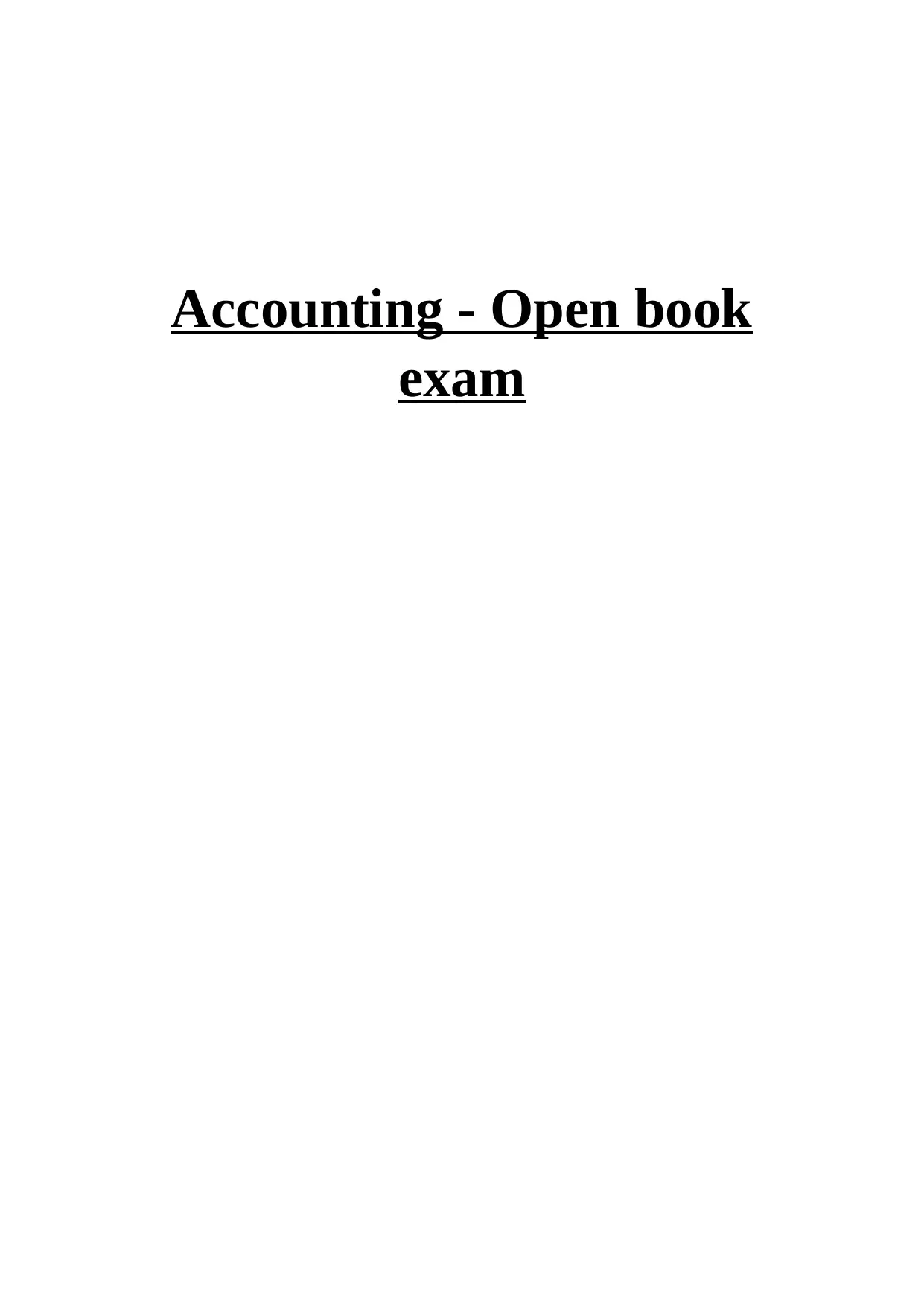
Accounting - Open book
exam
exam
Secure Best Marks with AI Grader
Need help grading? Try our AI Grader for instant feedback on your assignments.
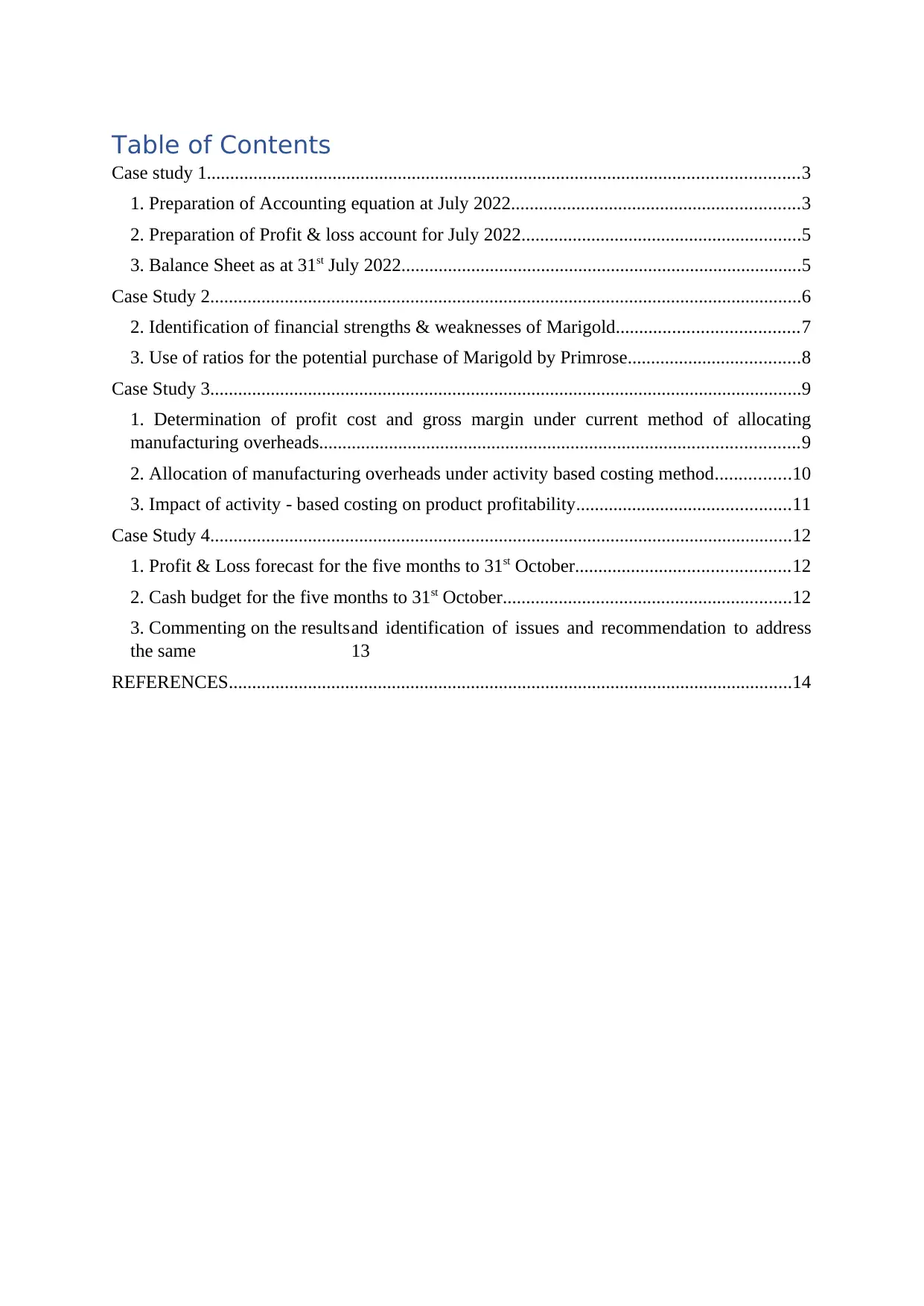
Table of Contents
Case study 1...............................................................................................................................3
1. Preparation of Accounting equation at July 2022..............................................................3
2. Preparation of Profit & loss account for July 2022............................................................5
3. Balance Sheet as at 31st July 2022......................................................................................5
Case Study 2...............................................................................................................................6
2. Identification of financial strengths & weaknesses of Marigold.......................................7
3. Use of ratios for the potential purchase of Marigold by Primrose.....................................8
Case Study 3...............................................................................................................................9
1. Determination of profit cost and gross margin under current method of allocating
manufacturing overheads.......................................................................................................9
2. Allocation of manufacturing overheads under activity based costing method................10
3. Impact of activity - based costing on product profitability..............................................11
Case Study 4.............................................................................................................................12
1. Profit & Loss forecast for the five months to 31st October..............................................12
2. Cash budget for the five months to 31st October..............................................................12
3. Commenting on the resultsand identification of issues and recommendation to address
the same 13
REFERENCES.........................................................................................................................14
Case study 1...............................................................................................................................3
1. Preparation of Accounting equation at July 2022..............................................................3
2. Preparation of Profit & loss account for July 2022............................................................5
3. Balance Sheet as at 31st July 2022......................................................................................5
Case Study 2...............................................................................................................................6
2. Identification of financial strengths & weaknesses of Marigold.......................................7
3. Use of ratios for the potential purchase of Marigold by Primrose.....................................8
Case Study 3...............................................................................................................................9
1. Determination of profit cost and gross margin under current method of allocating
manufacturing overheads.......................................................................................................9
2. Allocation of manufacturing overheads under activity based costing method................10
3. Impact of activity - based costing on product profitability..............................................11
Case Study 4.............................................................................................................................12
1. Profit & Loss forecast for the five months to 31st October..............................................12
2. Cash budget for the five months to 31st October..............................................................12
3. Commenting on the resultsand identification of issues and recommendation to address
the same 13
REFERENCES.........................................................................................................................14
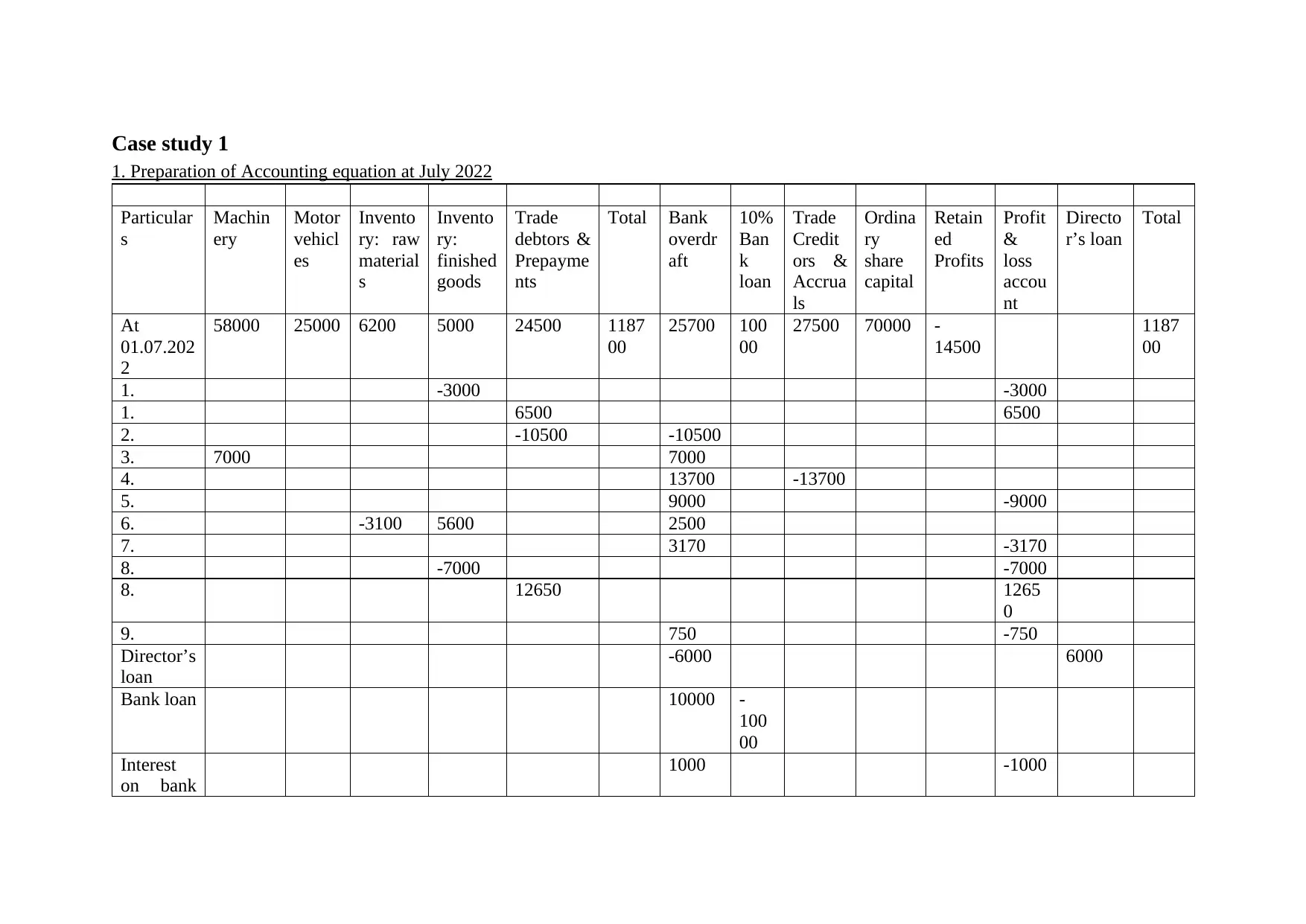
Case study 1
1. Preparation of Accounting equation at July 2022
Particular
s
Machin
ery
Motor
vehicl
es
Invento
ry: raw
material
s
Invento
ry:
finished
goods
Trade
debtors &
Prepayme
nts
Total Bank
overdr
aft
10%
Ban
k
loan
Trade
Credit
ors &
Accrua
ls
Ordina
ry
share
capital
Retain
ed
Profits
Profit
&
loss
accou
nt
Directo
r’s loan
Total
At
01.07.202
2
58000 25000 6200 5000 24500 1187
00
25700 100
00
27500 70000 -
14500
1187
00
1. -3000 -3000
1. 6500 6500
2. -10500 -10500
3. 7000 7000
4. 13700 -13700
5. 9000 -9000
6. -3100 5600 2500
7. 3170 -3170
8. -7000 -7000
8. 12650 1265
0
9. 750 -750
Director’s
loan
-6000 6000
Bank loan 10000 -
100
00
Interest
on bank
1000 -1000
1. Preparation of Accounting equation at July 2022
Particular
s
Machin
ery
Motor
vehicl
es
Invento
ry: raw
material
s
Invento
ry:
finished
goods
Trade
debtors &
Prepayme
nts
Total Bank
overdr
aft
10%
Ban
k
loan
Trade
Credit
ors &
Accrua
ls
Ordina
ry
share
capital
Retain
ed
Profits
Profit
&
loss
accou
nt
Directo
r’s loan
Total
At
01.07.202
2
58000 25000 6200 5000 24500 1187
00
25700 100
00
27500 70000 -
14500
1187
00
1. -3000 -3000
1. 6500 6500
2. -10500 -10500
3. 7000 7000
4. 13700 -13700
5. 9000 -9000
6. -3100 5600 2500
7. 3170 -3170
8. -7000 -7000
8. 12650 1265
0
9. 750 -750
Director’s
loan
-6000 6000
Bank loan 10000 -
100
00
Interest
on bank
1000 -1000
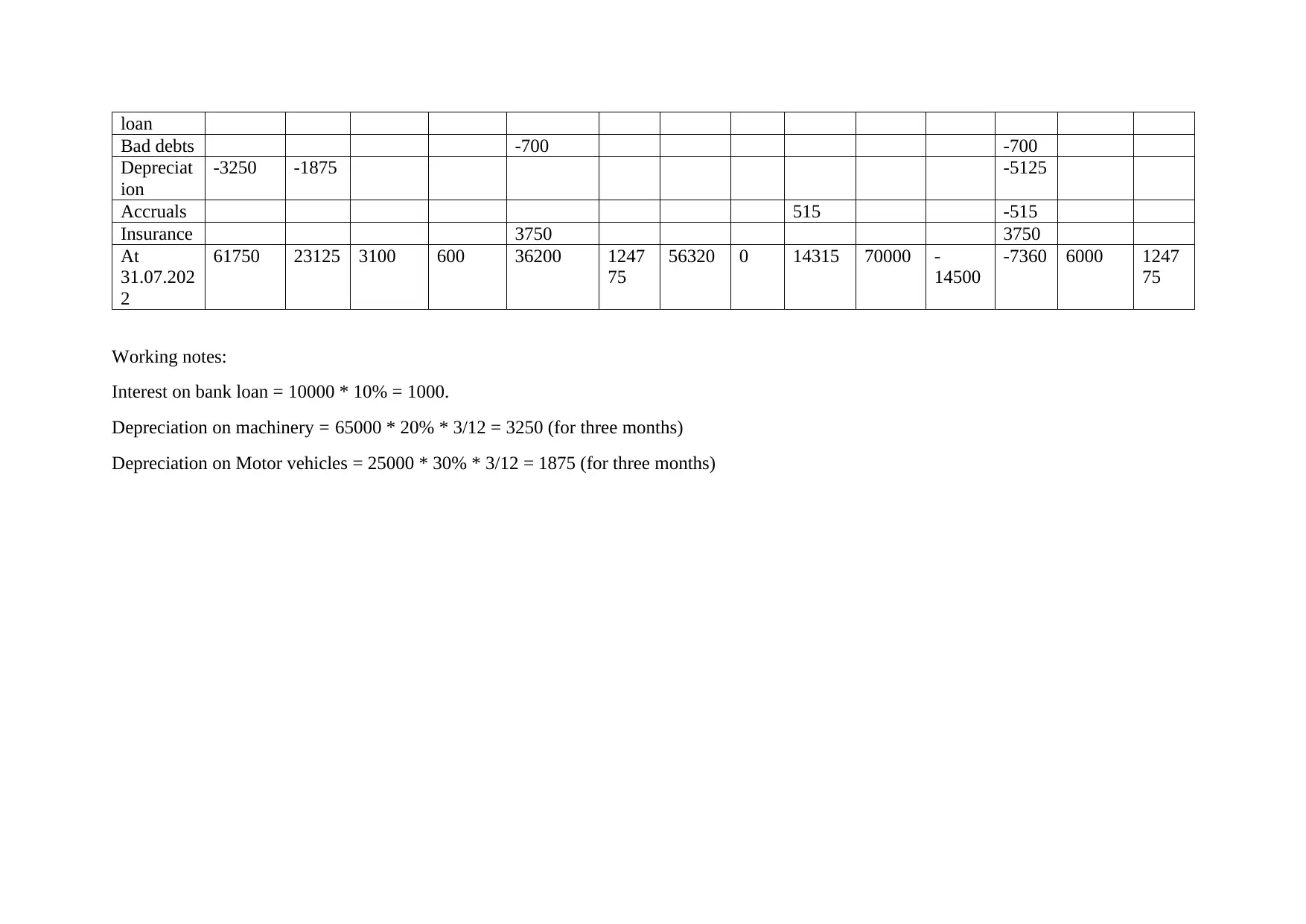
loan
Bad debts -700 -700
Depreciat
ion
-3250 -1875 -5125
Accruals 515 -515
Insurance 3750 3750
At
31.07.202
2
61750 23125 3100 600 36200 1247
75
56320 0 14315 70000 -
14500
-7360 6000 1247
75
Working notes:
Interest on bank loan = 10000 * 10% = 1000.
Depreciation on machinery = 65000 * 20% * 3/12 = 3250 (for three months)
Depreciation on Motor vehicles = 25000 * 30% * 3/12 = 1875 (for three months)
Bad debts -700 -700
Depreciat
ion
-3250 -1875 -5125
Accruals 515 -515
Insurance 3750 3750
At
31.07.202
2
61750 23125 3100 600 36200 1247
75
56320 0 14315 70000 -
14500
-7360 6000 1247
75
Working notes:
Interest on bank loan = 10000 * 10% = 1000.
Depreciation on machinery = 65000 * 20% * 3/12 = 3250 (for three months)
Depreciation on Motor vehicles = 25000 * 30% * 3/12 = 1875 (for three months)
Secure Best Marks with AI Grader
Need help grading? Try our AI Grader for instant feedback on your assignments.
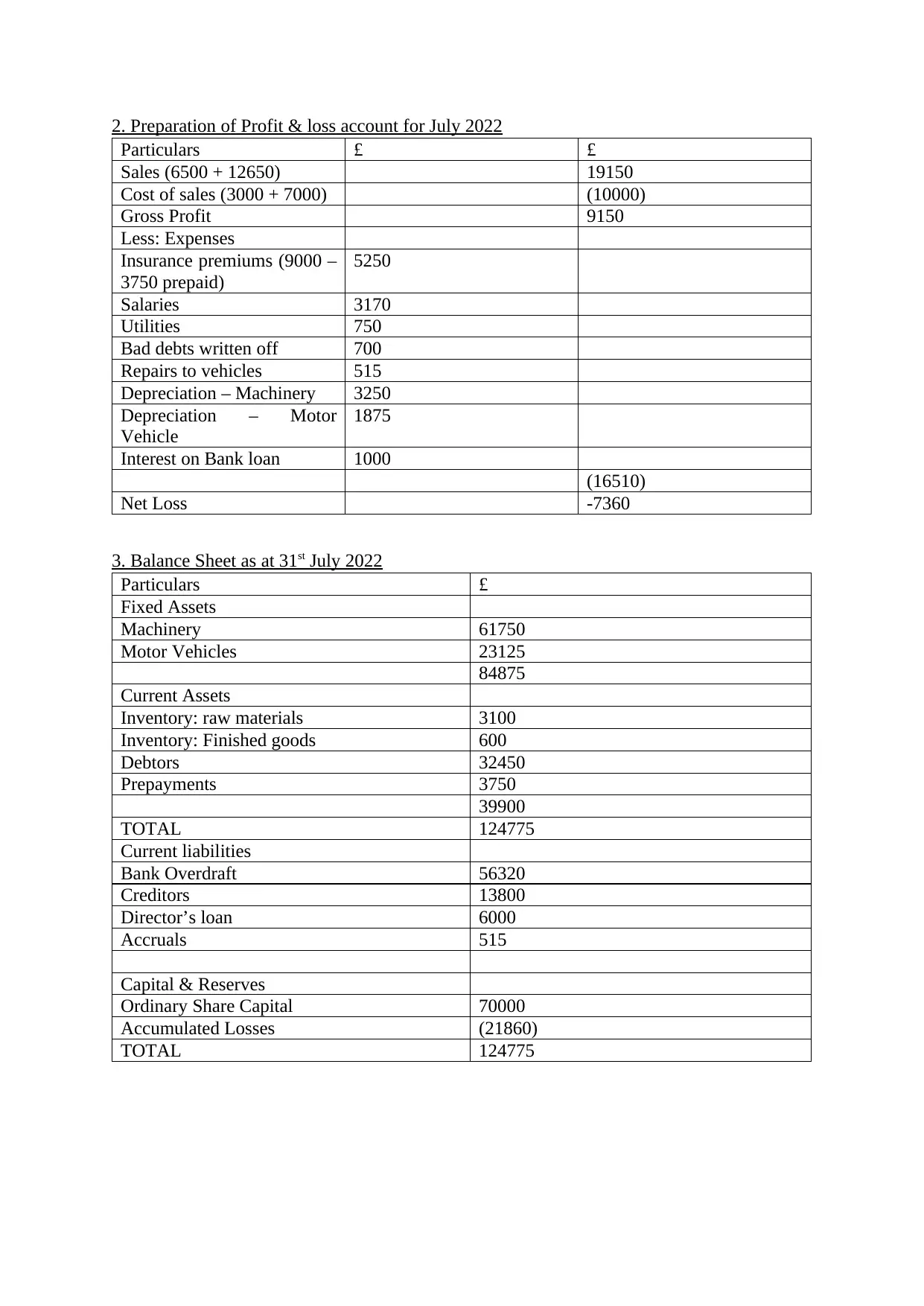
2. Preparation of Profit & loss account for July 2022
Particulars £ £
Sales (6500 + 12650) 19150
Cost of sales (3000 + 7000) (10000)
Gross Profit 9150
Less: Expenses
Insurance premiums (9000 –
3750 prepaid)
5250
Salaries 3170
Utilities 750
Bad debts written off 700
Repairs to vehicles 515
Depreciation – Machinery 3250
Depreciation – Motor
Vehicle
1875
Interest on Bank loan 1000
(16510)
Net Loss -7360
3. Balance Sheet as at 31st July 2022
Particulars £
Fixed Assets
Machinery 61750
Motor Vehicles 23125
84875
Current Assets
Inventory: raw materials 3100
Inventory: Finished goods 600
Debtors 32450
Prepayments 3750
39900
TOTAL 124775
Current liabilities
Bank Overdraft 56320
Creditors 13800
Director’s loan 6000
Accruals 515
Capital & Reserves
Ordinary Share Capital 70000
Accumulated Losses (21860)
TOTAL 124775
Particulars £ £
Sales (6500 + 12650) 19150
Cost of sales (3000 + 7000) (10000)
Gross Profit 9150
Less: Expenses
Insurance premiums (9000 –
3750 prepaid)
5250
Salaries 3170
Utilities 750
Bad debts written off 700
Repairs to vehicles 515
Depreciation – Machinery 3250
Depreciation – Motor
Vehicle
1875
Interest on Bank loan 1000
(16510)
Net Loss -7360
3. Balance Sheet as at 31st July 2022
Particulars £
Fixed Assets
Machinery 61750
Motor Vehicles 23125
84875
Current Assets
Inventory: raw materials 3100
Inventory: Finished goods 600
Debtors 32450
Prepayments 3750
39900
TOTAL 124775
Current liabilities
Bank Overdraft 56320
Creditors 13800
Director’s loan 6000
Accruals 515
Capital & Reserves
Ordinary Share Capital 70000
Accumulated Losses (21860)
TOTAL 124775
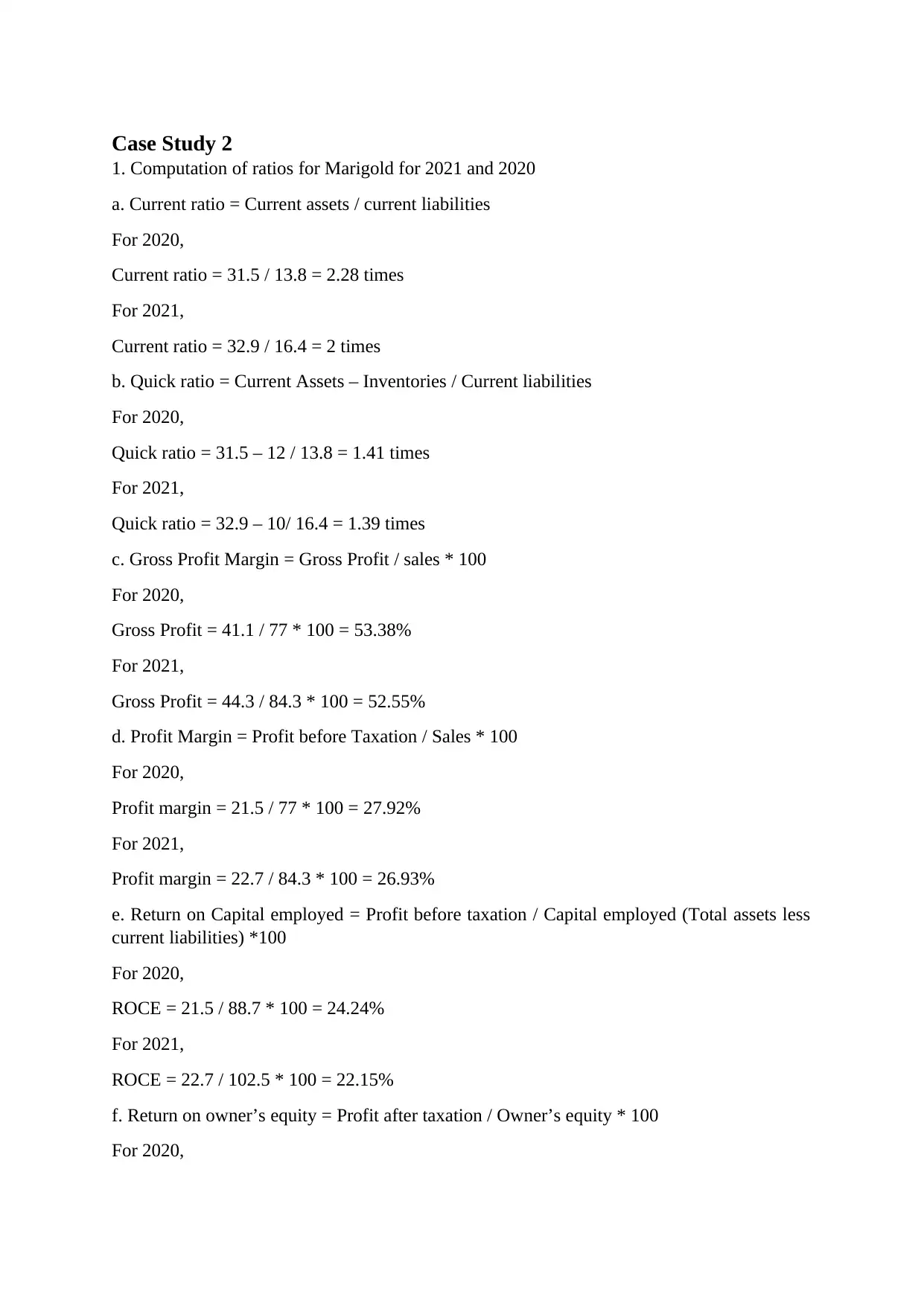
Case Study 2
1. Computation of ratios for Marigold for 2021 and 2020
a. Current ratio = Current assets / current liabilities
For 2020,
Current ratio = 31.5 / 13.8 = 2.28 times
For 2021,
Current ratio = 32.9 / 16.4 = 2 times
b. Quick ratio = Current Assets – Inventories / Current liabilities
For 2020,
Quick ratio = 31.5 – 12 / 13.8 = 1.41 times
For 2021,
Quick ratio = 32.9 – 10/ 16.4 = 1.39 times
c. Gross Profit Margin = Gross Profit / sales * 100
For 2020,
Gross Profit = 41.1 / 77 * 100 = 53.38%
For 2021,
Gross Profit = 44.3 / 84.3 * 100 = 52.55%
d. Profit Margin = Profit before Taxation / Sales * 100
For 2020,
Profit margin = 21.5 / 77 * 100 = 27.92%
For 2021,
Profit margin = 22.7 / 84.3 * 100 = 26.93%
e. Return on Capital employed = Profit before taxation / Capital employed (Total assets less
current liabilities) *100
For 2020,
ROCE = 21.5 / 88.7 * 100 = 24.24%
For 2021,
ROCE = 22.7 / 102.5 * 100 = 22.15%
f. Return on owner’s equity = Profit after taxation / Owner’s equity * 100
For 2020,
1. Computation of ratios for Marigold for 2021 and 2020
a. Current ratio = Current assets / current liabilities
For 2020,
Current ratio = 31.5 / 13.8 = 2.28 times
For 2021,
Current ratio = 32.9 / 16.4 = 2 times
b. Quick ratio = Current Assets – Inventories / Current liabilities
For 2020,
Quick ratio = 31.5 – 12 / 13.8 = 1.41 times
For 2021,
Quick ratio = 32.9 – 10/ 16.4 = 1.39 times
c. Gross Profit Margin = Gross Profit / sales * 100
For 2020,
Gross Profit = 41.1 / 77 * 100 = 53.38%
For 2021,
Gross Profit = 44.3 / 84.3 * 100 = 52.55%
d. Profit Margin = Profit before Taxation / Sales * 100
For 2020,
Profit margin = 21.5 / 77 * 100 = 27.92%
For 2021,
Profit margin = 22.7 / 84.3 * 100 = 26.93%
e. Return on Capital employed = Profit before taxation / Capital employed (Total assets less
current liabilities) *100
For 2020,
ROCE = 21.5 / 88.7 * 100 = 24.24%
For 2021,
ROCE = 22.7 / 102.5 * 100 = 22.15%
f. Return on owner’s equity = Profit after taxation / Owner’s equity * 100
For 2020,
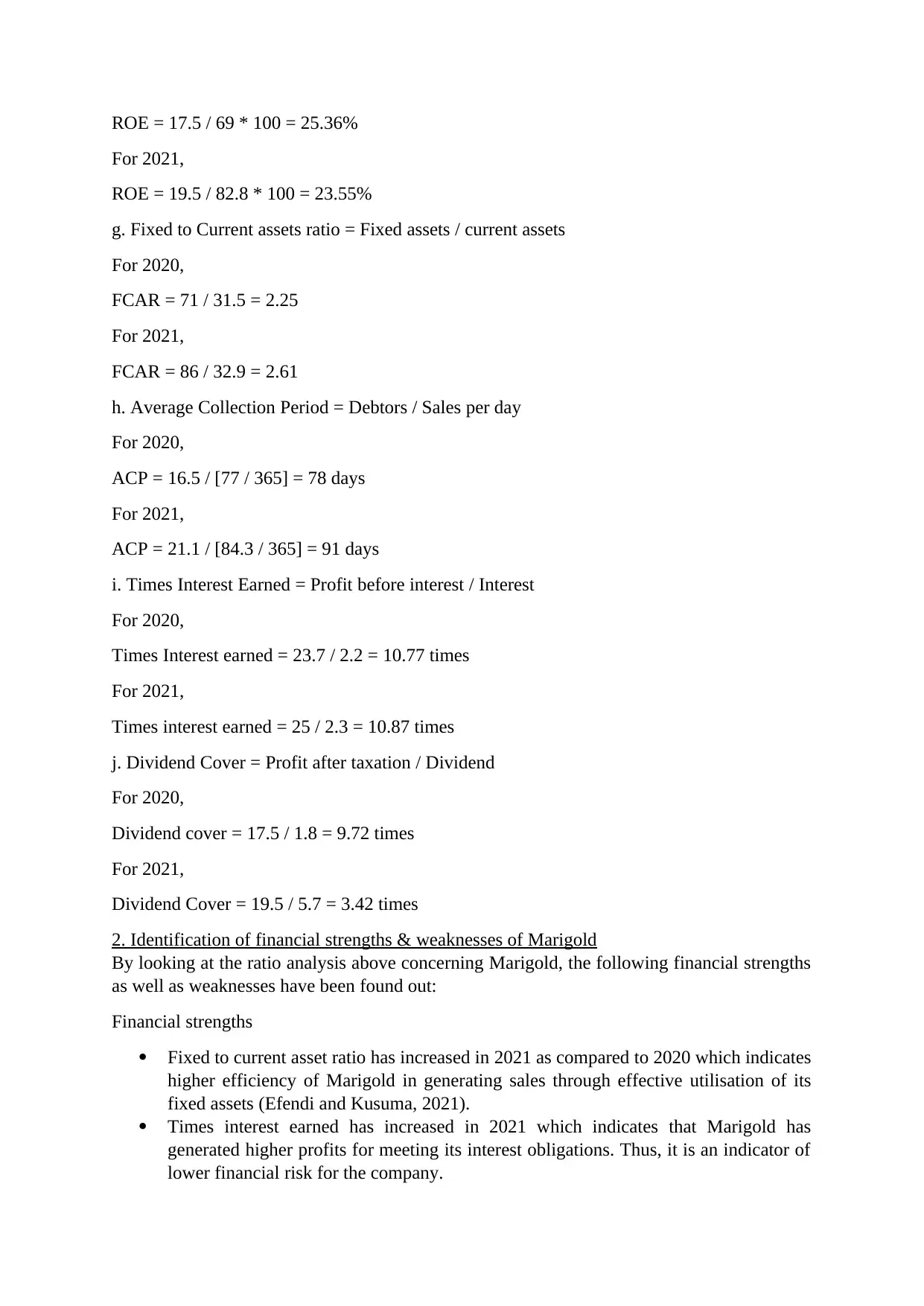
ROE = 17.5 / 69 * 100 = 25.36%
For 2021,
ROE = 19.5 / 82.8 * 100 = 23.55%
g. Fixed to Current assets ratio = Fixed assets / current assets
For 2020,
FCAR = 71 / 31.5 = 2.25
For 2021,
FCAR = 86 / 32.9 = 2.61
h. Average Collection Period = Debtors / Sales per day
For 2020,
ACP = 16.5 / [77 / 365] = 78 days
For 2021,
ACP = 21.1 / [84.3 / 365] = 91 days
i. Times Interest Earned = Profit before interest / Interest
For 2020,
Times Interest earned = 23.7 / 2.2 = 10.77 times
For 2021,
Times interest earned = 25 / 2.3 = 10.87 times
j. Dividend Cover = Profit after taxation / Dividend
For 2020,
Dividend cover = 17.5 / 1.8 = 9.72 times
For 2021,
Dividend Cover = 19.5 / 5.7 = 3.42 times
2. Identification of financial strengths & weaknesses of Marigold
By looking at the ratio analysis above concerning Marigold, the following financial strengths
as well as weaknesses have been found out:
Financial strengths
Fixed to current asset ratio has increased in 2021 as compared to 2020 which indicates
higher efficiency of Marigold in generating sales through effective utilisation of its
fixed assets (Efendi and Kusuma, 2021).
Times interest earned has increased in 2021 which indicates that Marigold has
generated higher profits for meeting its interest obligations. Thus, it is an indicator of
lower financial risk for the company.
For 2021,
ROE = 19.5 / 82.8 * 100 = 23.55%
g. Fixed to Current assets ratio = Fixed assets / current assets
For 2020,
FCAR = 71 / 31.5 = 2.25
For 2021,
FCAR = 86 / 32.9 = 2.61
h. Average Collection Period = Debtors / Sales per day
For 2020,
ACP = 16.5 / [77 / 365] = 78 days
For 2021,
ACP = 21.1 / [84.3 / 365] = 91 days
i. Times Interest Earned = Profit before interest / Interest
For 2020,
Times Interest earned = 23.7 / 2.2 = 10.77 times
For 2021,
Times interest earned = 25 / 2.3 = 10.87 times
j. Dividend Cover = Profit after taxation / Dividend
For 2020,
Dividend cover = 17.5 / 1.8 = 9.72 times
For 2021,
Dividend Cover = 19.5 / 5.7 = 3.42 times
2. Identification of financial strengths & weaknesses of Marigold
By looking at the ratio analysis above concerning Marigold, the following financial strengths
as well as weaknesses have been found out:
Financial strengths
Fixed to current asset ratio has increased in 2021 as compared to 2020 which indicates
higher efficiency of Marigold in generating sales through effective utilisation of its
fixed assets (Efendi and Kusuma, 2021).
Times interest earned has increased in 2021 which indicates that Marigold has
generated higher profits for meeting its interest obligations. Thus, it is an indicator of
lower financial risk for the company.
Paraphrase This Document
Need a fresh take? Get an instant paraphrase of this document with our AI Paraphraser
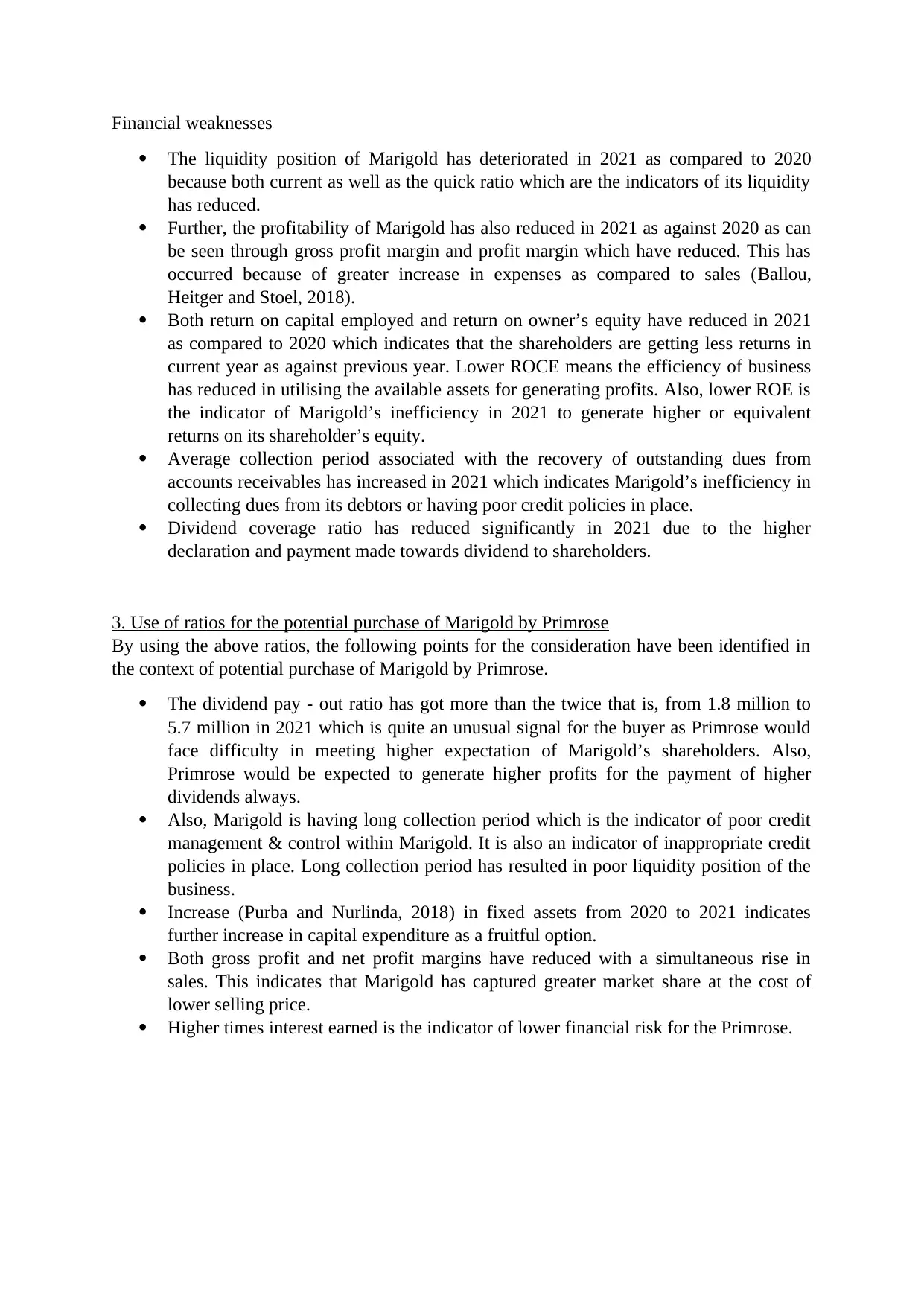
Financial weaknesses
The liquidity position of Marigold has deteriorated in 2021 as compared to 2020
because both current as well as the quick ratio which are the indicators of its liquidity
has reduced.
Further, the profitability of Marigold has also reduced in 2021 as against 2020 as can
be seen through gross profit margin and profit margin which have reduced. This has
occurred because of greater increase in expenses as compared to sales (Ballou,
Heitger and Stoel, 2018).
Both return on capital employed and return on owner’s equity have reduced in 2021
as compared to 2020 which indicates that the shareholders are getting less returns in
current year as against previous year. Lower ROCE means the efficiency of business
has reduced in utilising the available assets for generating profits. Also, lower ROE is
the indicator of Marigold’s inefficiency in 2021 to generate higher or equivalent
returns on its shareholder’s equity.
Average collection period associated with the recovery of outstanding dues from
accounts receivables has increased in 2021 which indicates Marigold’s inefficiency in
collecting dues from its debtors or having poor credit policies in place.
Dividend coverage ratio has reduced significantly in 2021 due to the higher
declaration and payment made towards dividend to shareholders.
3. Use of ratios for the potential purchase of Marigold by Primrose
By using the above ratios, the following points for the consideration have been identified in
the context of potential purchase of Marigold by Primrose.
The dividend pay - out ratio has got more than the twice that is, from 1.8 million to
5.7 million in 2021 which is quite an unusual signal for the buyer as Primrose would
face difficulty in meeting higher expectation of Marigold’s shareholders. Also,
Primrose would be expected to generate higher profits for the payment of higher
dividends always.
Also, Marigold is having long collection period which is the indicator of poor credit
management & control within Marigold. It is also an indicator of inappropriate credit
policies in place. Long collection period has resulted in poor liquidity position of the
business.
Increase (Purba and Nurlinda, 2018) in fixed assets from 2020 to 2021 indicates
further increase in capital expenditure as a fruitful option.
Both gross profit and net profit margins have reduced with a simultaneous rise in
sales. This indicates that Marigold has captured greater market share at the cost of
lower selling price.
Higher times interest earned is the indicator of lower financial risk for the Primrose.
The liquidity position of Marigold has deteriorated in 2021 as compared to 2020
because both current as well as the quick ratio which are the indicators of its liquidity
has reduced.
Further, the profitability of Marigold has also reduced in 2021 as against 2020 as can
be seen through gross profit margin and profit margin which have reduced. This has
occurred because of greater increase in expenses as compared to sales (Ballou,
Heitger and Stoel, 2018).
Both return on capital employed and return on owner’s equity have reduced in 2021
as compared to 2020 which indicates that the shareholders are getting less returns in
current year as against previous year. Lower ROCE means the efficiency of business
has reduced in utilising the available assets for generating profits. Also, lower ROE is
the indicator of Marigold’s inefficiency in 2021 to generate higher or equivalent
returns on its shareholder’s equity.
Average collection period associated with the recovery of outstanding dues from
accounts receivables has increased in 2021 which indicates Marigold’s inefficiency in
collecting dues from its debtors or having poor credit policies in place.
Dividend coverage ratio has reduced significantly in 2021 due to the higher
declaration and payment made towards dividend to shareholders.
3. Use of ratios for the potential purchase of Marigold by Primrose
By using the above ratios, the following points for the consideration have been identified in
the context of potential purchase of Marigold by Primrose.
The dividend pay - out ratio has got more than the twice that is, from 1.8 million to
5.7 million in 2021 which is quite an unusual signal for the buyer as Primrose would
face difficulty in meeting higher expectation of Marigold’s shareholders. Also,
Primrose would be expected to generate higher profits for the payment of higher
dividends always.
Also, Marigold is having long collection period which is the indicator of poor credit
management & control within Marigold. It is also an indicator of inappropriate credit
policies in place. Long collection period has resulted in poor liquidity position of the
business.
Increase (Purba and Nurlinda, 2018) in fixed assets from 2020 to 2021 indicates
further increase in capital expenditure as a fruitful option.
Both gross profit and net profit margins have reduced with a simultaneous rise in
sales. This indicates that Marigold has captured greater market share at the cost of
lower selling price.
Higher times interest earned is the indicator of lower financial risk for the Primrose.
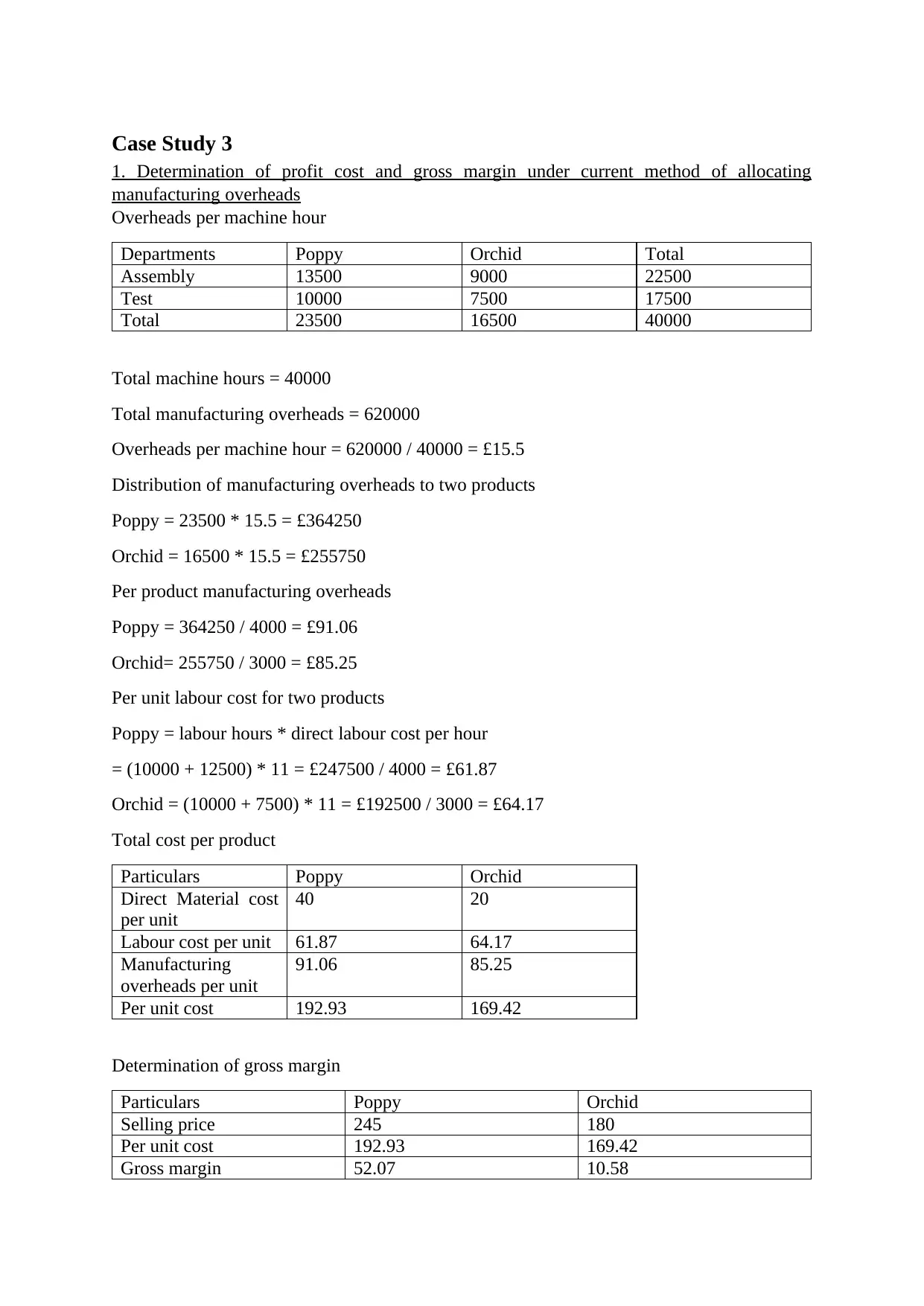
Case Study 3
1. Determination of profit cost and gross margin under current method of allocating
manufacturing overheads
Overheads per machine hour
Departments Poppy Orchid Total
Assembly 13500 9000 22500
Test 10000 7500 17500
Total 23500 16500 40000
Total machine hours = 40000
Total manufacturing overheads = 620000
Overheads per machine hour = 620000 / 40000 = £15.5
Distribution of manufacturing overheads to two products
Poppy = 23500 * 15.5 = £364250
Orchid = 16500 * 15.5 = £255750
Per product manufacturing overheads
Poppy = 364250 / 4000 = £91.06
Orchid= 255750 / 3000 = £85.25
Per unit labour cost for two products
Poppy = labour hours * direct labour cost per hour
= (10000 + 12500) * 11 = £247500 / 4000 = £61.87
Orchid = (10000 + 7500) * 11 = £192500 / 3000 = £64.17
Total cost per product
Particulars Poppy Orchid
Direct Material cost
per unit
40 20
Labour cost per unit 61.87 64.17
Manufacturing
overheads per unit
91.06 85.25
Per unit cost 192.93 169.42
Determination of gross margin
Particulars Poppy Orchid
Selling price 245 180
Per unit cost 192.93 169.42
Gross margin 52.07 10.58
1. Determination of profit cost and gross margin under current method of allocating
manufacturing overheads
Overheads per machine hour
Departments Poppy Orchid Total
Assembly 13500 9000 22500
Test 10000 7500 17500
Total 23500 16500 40000
Total machine hours = 40000
Total manufacturing overheads = 620000
Overheads per machine hour = 620000 / 40000 = £15.5
Distribution of manufacturing overheads to two products
Poppy = 23500 * 15.5 = £364250
Orchid = 16500 * 15.5 = £255750
Per product manufacturing overheads
Poppy = 364250 / 4000 = £91.06
Orchid= 255750 / 3000 = £85.25
Per unit labour cost for two products
Poppy = labour hours * direct labour cost per hour
= (10000 + 12500) * 11 = £247500 / 4000 = £61.87
Orchid = (10000 + 7500) * 11 = £192500 / 3000 = £64.17
Total cost per product
Particulars Poppy Orchid
Direct Material cost
per unit
40 20
Labour cost per unit 61.87 64.17
Manufacturing
overheads per unit
91.06 85.25
Per unit cost 192.93 169.42
Determination of gross margin
Particulars Poppy Orchid
Selling price 245 180
Per unit cost 192.93 169.42
Gross margin 52.07 10.58
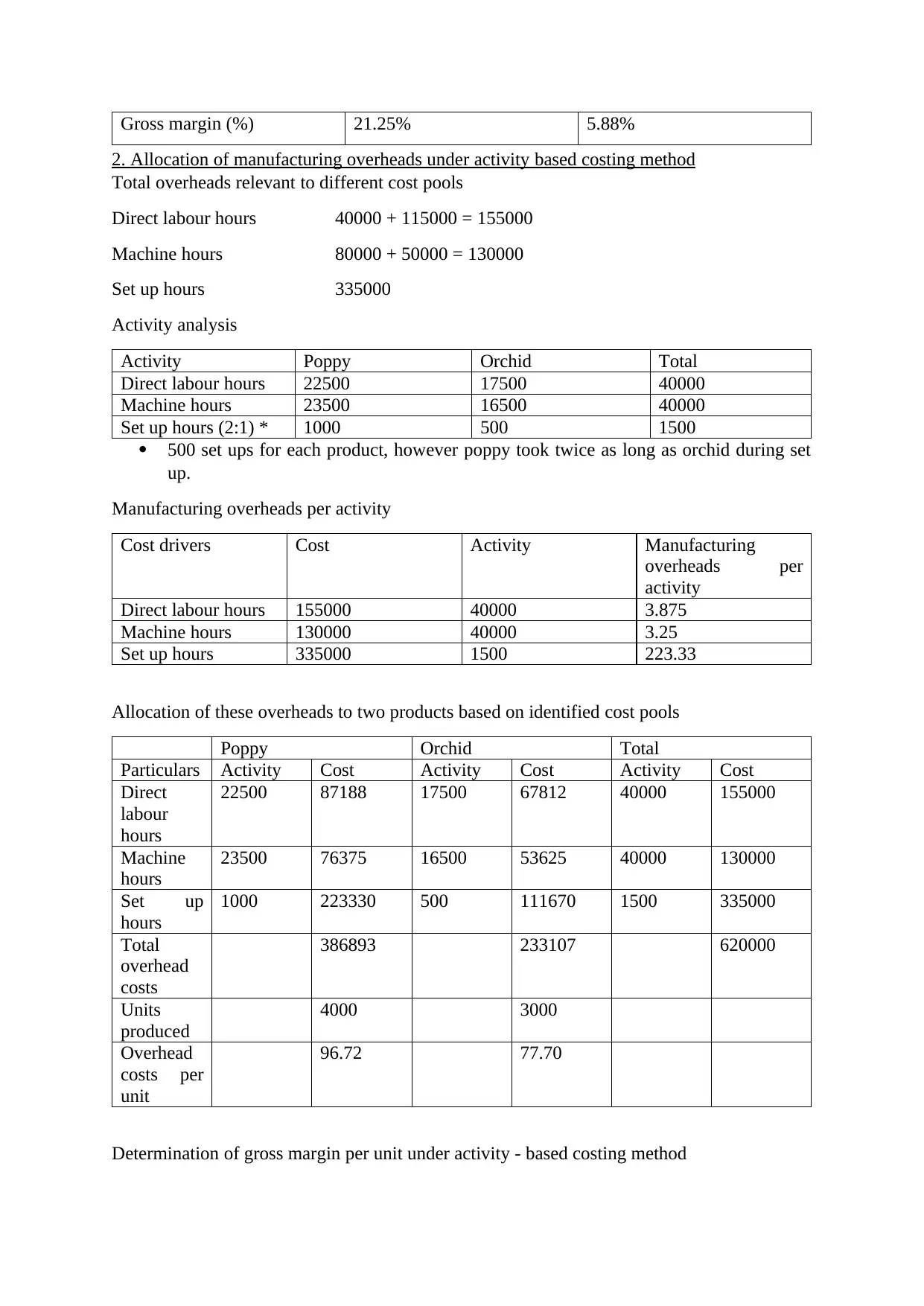
Gross margin (%) 21.25% 5.88%
2. Allocation of manufacturing overheads under activity based costing method
Total overheads relevant to different cost pools
Direct labour hours 40000 + 115000 = 155000
Machine hours 80000 + 50000 = 130000
Set up hours 335000
Activity analysis
Activity Poppy Orchid Total
Direct labour hours 22500 17500 40000
Machine hours 23500 16500 40000
Set up hours (2:1) * 1000 500 1500
500 set ups for each product, however poppy took twice as long as orchid during set
up.
Manufacturing overheads per activity
Cost drivers Cost Activity Manufacturing
overheads per
activity
Direct labour hours 155000 40000 3.875
Machine hours 130000 40000 3.25
Set up hours 335000 1500 223.33
Allocation of these overheads to two products based on identified cost pools
Poppy Orchid Total
Particulars Activity Cost Activity Cost Activity Cost
Direct
labour
hours
22500 87188 17500 67812 40000 155000
Machine
hours
23500 76375 16500 53625 40000 130000
Set up
hours
1000 223330 500 111670 1500 335000
Total
overhead
costs
386893 233107 620000
Units
produced
4000 3000
Overhead
costs per
unit
96.72 77.70
Determination of gross margin per unit under activity - based costing method
2. Allocation of manufacturing overheads under activity based costing method
Total overheads relevant to different cost pools
Direct labour hours 40000 + 115000 = 155000
Machine hours 80000 + 50000 = 130000
Set up hours 335000
Activity analysis
Activity Poppy Orchid Total
Direct labour hours 22500 17500 40000
Machine hours 23500 16500 40000
Set up hours (2:1) * 1000 500 1500
500 set ups for each product, however poppy took twice as long as orchid during set
up.
Manufacturing overheads per activity
Cost drivers Cost Activity Manufacturing
overheads per
activity
Direct labour hours 155000 40000 3.875
Machine hours 130000 40000 3.25
Set up hours 335000 1500 223.33
Allocation of these overheads to two products based on identified cost pools
Poppy Orchid Total
Particulars Activity Cost Activity Cost Activity Cost
Direct
labour
hours
22500 87188 17500 67812 40000 155000
Machine
hours
23500 76375 16500 53625 40000 130000
Set up
hours
1000 223330 500 111670 1500 335000
Total
overhead
costs
386893 233107 620000
Units
produced
4000 3000
Overhead
costs per
unit
96.72 77.70
Determination of gross margin per unit under activity - based costing method
Secure Best Marks with AI Grader
Need help grading? Try our AI Grader for instant feedback on your assignments.

Particulars Poppy Orchid
Selling price (a) 245 180
Less:
Direct material cost 40 20
Labour cost per unit (same
as above)
61.87 64.17
Manufacturing overhead per
unit
96.72 77.70
Total cost (b) 198.59 161.87
Gross margin (a - b) 46.41 18.13
Gross margin (%) 18.94% 10.07%
3. Impact of activity - based costing on product profitability
Products ABC Current costing
Poppy 18.94% 21.25%
Orchid 10.07% 5.88%
Through the above table, it can be clearly seen than Poppy is found to be profitable in case of
both the costing techniques. However, poppy’s profitability margin has reduced in activity -
based costing method while the profit margin of Orchid has increased. This has happened
because of more accurate allocation of overhead costs under ABC costing method whereas in
case of current costing method where allocation of overheads is done on machine hours, the
product that is consuming more of machine hours get unreasonably more proportion of
manufacturing overheads (Fleischman and McLean, 2020). This led to reduction in their
profit margin. Therefore, ABC method by depicting current cost & profit structure for each
product assists in making decisions pertaining to production & pricing. Therefore, under
ABC method, the profitability of Poppy has reduced while the profitability of Orchid has
increased.
Selling price (a) 245 180
Less:
Direct material cost 40 20
Labour cost per unit (same
as above)
61.87 64.17
Manufacturing overhead per
unit
96.72 77.70
Total cost (b) 198.59 161.87
Gross margin (a - b) 46.41 18.13
Gross margin (%) 18.94% 10.07%
3. Impact of activity - based costing on product profitability
Products ABC Current costing
Poppy 18.94% 21.25%
Orchid 10.07% 5.88%
Through the above table, it can be clearly seen than Poppy is found to be profitable in case of
both the costing techniques. However, poppy’s profitability margin has reduced in activity -
based costing method while the profit margin of Orchid has increased. This has happened
because of more accurate allocation of overhead costs under ABC costing method whereas in
case of current costing method where allocation of overheads is done on machine hours, the
product that is consuming more of machine hours get unreasonably more proportion of
manufacturing overheads (Fleischman and McLean, 2020). This led to reduction in their
profit margin. Therefore, ABC method by depicting current cost & profit structure for each
product assists in making decisions pertaining to production & pricing. Therefore, under
ABC method, the profitability of Poppy has reduced while the profitability of Orchid has
increased.

Case Study 4
1. Profit & Loss forecast for the five months to 31st October
Particulars €
Sales 2140000 [400000 + 240000 + 200000
+ 600000 + 700000]
Purchases (1219000) [175000 + 144000 + 120000
+ 360000 + 420000]
Direct labour cost (226750) [44250 * 3 + 47000 * 2]
Salaries (70500) 14100 * 5
Marketing cost (42450) [6660 * 5 + 9150]
Depreciation (66250) [13250 *5]
Administrative staff salaries (66750) [13350 * 5]
Overheads (215000) [43000 * 5]
Profit for the period 233300
2. Cash budget for the five months to 31st October
Particulars June July August Septembe
r
October
Cash In
Receivables - March 54000
Receivables - April 180000 60000
Receivables - May 150000 225000 75000
Receivables - June 40000 120000 180000 60000
Receivables - July 24000 72000 108000 36000
Receivables - August 20000 60000 90000
Receivables - September 60000 180000
Receivables - October 70000
Bank Loan 350000
Total 424000 429000 697000 288000 376000
Cash Out
Payables - March -
195000
Payables - April -
244000
Payables - May -
375000
Payables - June -175000
Payables - july -
144000
Direct labour costs -44250 -47000 -47000 -44250 -44250
Salaries (Sales & marketing) -14100 -14100 -14100 -14100 -14100
Marketing costs -6660 -15810 -6660 -6660 -6660
Salaries (Administrative) -13350 -13350 -13350 -13350 -13350
Overheads -43000 -43000 -43000 -43000 -43000
Annual Profit Sharing Bonus -72000
1. Profit & Loss forecast for the five months to 31st October
Particulars €
Sales 2140000 [400000 + 240000 + 200000
+ 600000 + 700000]
Purchases (1219000) [175000 + 144000 + 120000
+ 360000 + 420000]
Direct labour cost (226750) [44250 * 3 + 47000 * 2]
Salaries (70500) 14100 * 5
Marketing cost (42450) [6660 * 5 + 9150]
Depreciation (66250) [13250 *5]
Administrative staff salaries (66750) [13350 * 5]
Overheads (215000) [43000 * 5]
Profit for the period 233300
2. Cash budget for the five months to 31st October
Particulars June July August Septembe
r
October
Cash In
Receivables - March 54000
Receivables - April 180000 60000
Receivables - May 150000 225000 75000
Receivables - June 40000 120000 180000 60000
Receivables - July 24000 72000 108000 36000
Receivables - August 20000 60000 90000
Receivables - September 60000 180000
Receivables - October 70000
Bank Loan 350000
Total 424000 429000 697000 288000 376000
Cash Out
Payables - March -
195000
Payables - April -
244000
Payables - May -
375000
Payables - June -175000
Payables - july -
144000
Direct labour costs -44250 -47000 -47000 -44250 -44250
Salaries (Sales & marketing) -14100 -14100 -14100 -14100 -14100
Marketing costs -6660 -15810 -6660 -6660 -6660
Salaries (Administrative) -13350 -13350 -13350 -13350 -13350
Overheads -43000 -43000 -43000 -43000 -43000
Annual Profit Sharing Bonus -72000
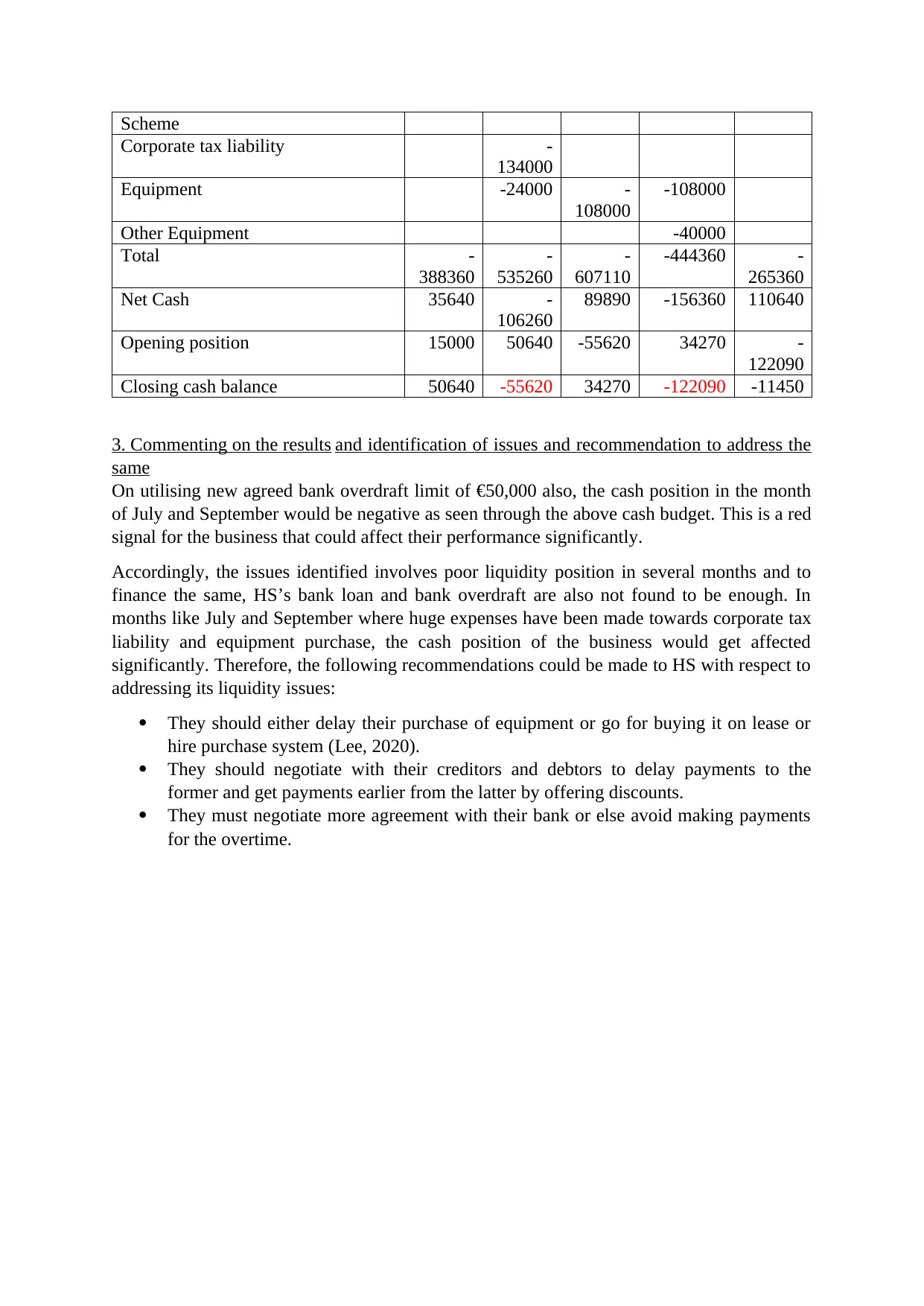
Scheme
Corporate tax liability -
134000
Equipment -24000 -
108000
-108000
Other Equipment -40000
Total -
388360
-
535260
-
607110
-444360 -
265360
Net Cash 35640 -
106260
89890 -156360 110640
Opening position 15000 50640 -55620 34270 -
122090
Closing cash balance 50640 -55620 34270 -122090 -11450
3. Commenting on the results and identification of issues and recommendation to address the
same
On utilising new agreed bank overdraft limit of €50,000 also, the cash position in the month
of July and September would be negative as seen through the above cash budget. This is a red
signal for the business that could affect their performance significantly.
Accordingly, the issues identified involves poor liquidity position in several months and to
finance the same, HS’s bank loan and bank overdraft are also not found to be enough. In
months like July and September where huge expenses have been made towards corporate tax
liability and equipment purchase, the cash position of the business would get affected
significantly. Therefore, the following recommendations could be made to HS with respect to
addressing its liquidity issues:
They should either delay their purchase of equipment or go for buying it on lease or
hire purchase system (Lee, 2020).
They should negotiate with their creditors and debtors to delay payments to the
former and get payments earlier from the latter by offering discounts.
They must negotiate more agreement with their bank or else avoid making payments
for the overtime.
Corporate tax liability -
134000
Equipment -24000 -
108000
-108000
Other Equipment -40000
Total -
388360
-
535260
-
607110
-444360 -
265360
Net Cash 35640 -
106260
89890 -156360 110640
Opening position 15000 50640 -55620 34270 -
122090
Closing cash balance 50640 -55620 34270 -122090 -11450
3. Commenting on the results and identification of issues and recommendation to address the
same
On utilising new agreed bank overdraft limit of €50,000 also, the cash position in the month
of July and September would be negative as seen through the above cash budget. This is a red
signal for the business that could affect their performance significantly.
Accordingly, the issues identified involves poor liquidity position in several months and to
finance the same, HS’s bank loan and bank overdraft are also not found to be enough. In
months like July and September where huge expenses have been made towards corporate tax
liability and equipment purchase, the cash position of the business would get affected
significantly. Therefore, the following recommendations could be made to HS with respect to
addressing its liquidity issues:
They should either delay their purchase of equipment or go for buying it on lease or
hire purchase system (Lee, 2020).
They should negotiate with their creditors and debtors to delay payments to the
former and get payments earlier from the latter by offering discounts.
They must negotiate more agreement with their bank or else avoid making payments
for the overtime.
Paraphrase This Document
Need a fresh take? Get an instant paraphrase of this document with our AI Paraphraser
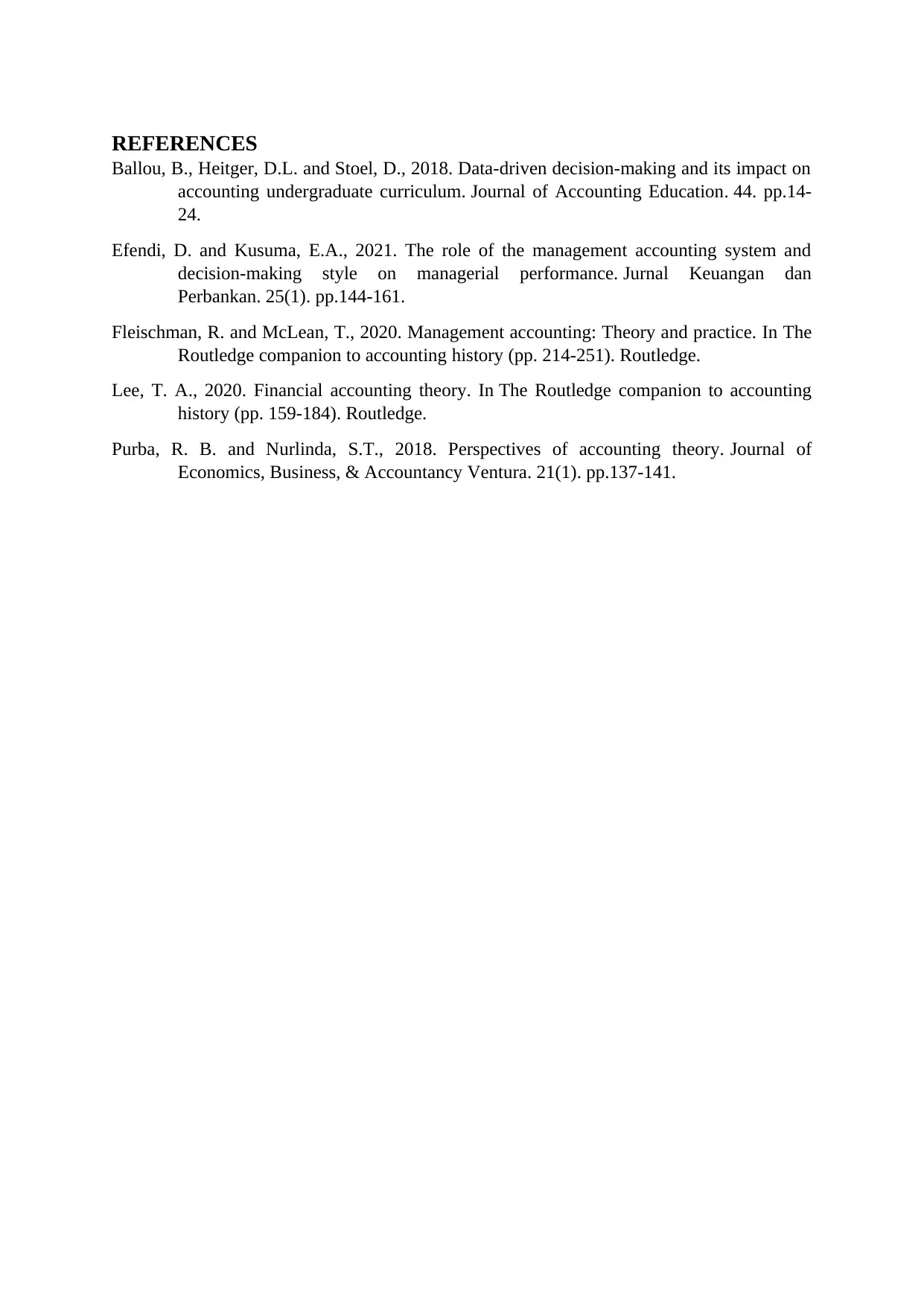
REFERENCES
Ballou, B., Heitger, D.L. and Stoel, D., 2018. Data-driven decision-making and its impact on
accounting undergraduate curriculum. Journal of Accounting Education. 44. pp.14-
24.
Efendi, D. and Kusuma, E.A., 2021. The role of the management accounting system and
decision-making style on managerial performance. Jurnal Keuangan dan
Perbankan. 25(1). pp.144-161.
Fleischman, R. and McLean, T., 2020. Management accounting: Theory and practice. In The
Routledge companion to accounting history (pp. 214-251). Routledge.
Lee, T. A., 2020. Financial accounting theory. In The Routledge companion to accounting
history (pp. 159-184). Routledge.
Purba, R. B. and Nurlinda, S.T., 2018. Perspectives of accounting theory. Journal of
Economics, Business, & Accountancy Ventura. 21(1). pp.137-141.
Ballou, B., Heitger, D.L. and Stoel, D., 2018. Data-driven decision-making and its impact on
accounting undergraduate curriculum. Journal of Accounting Education. 44. pp.14-
24.
Efendi, D. and Kusuma, E.A., 2021. The role of the management accounting system and
decision-making style on managerial performance. Jurnal Keuangan dan
Perbankan. 25(1). pp.144-161.
Fleischman, R. and McLean, T., 2020. Management accounting: Theory and practice. In The
Routledge companion to accounting history (pp. 214-251). Routledge.
Lee, T. A., 2020. Financial accounting theory. In The Routledge companion to accounting
history (pp. 159-184). Routledge.
Purba, R. B. and Nurlinda, S.T., 2018. Perspectives of accounting theory. Journal of
Economics, Business, & Accountancy Ventura. 21(1). pp.137-141.
1 out of 14
Your All-in-One AI-Powered Toolkit for Academic Success.
+13062052269
info@desklib.com
Available 24*7 on WhatsApp / Email
![[object Object]](/_next/static/media/star-bottom.7253800d.svg)
Unlock your academic potential
© 2024 | Zucol Services PVT LTD | All rights reserved.